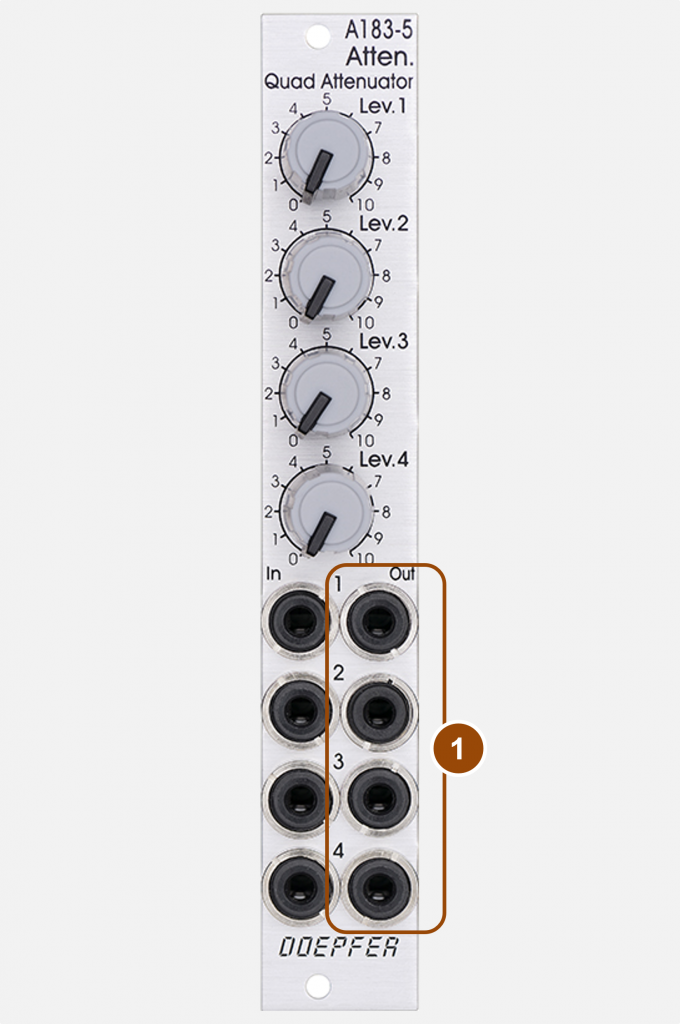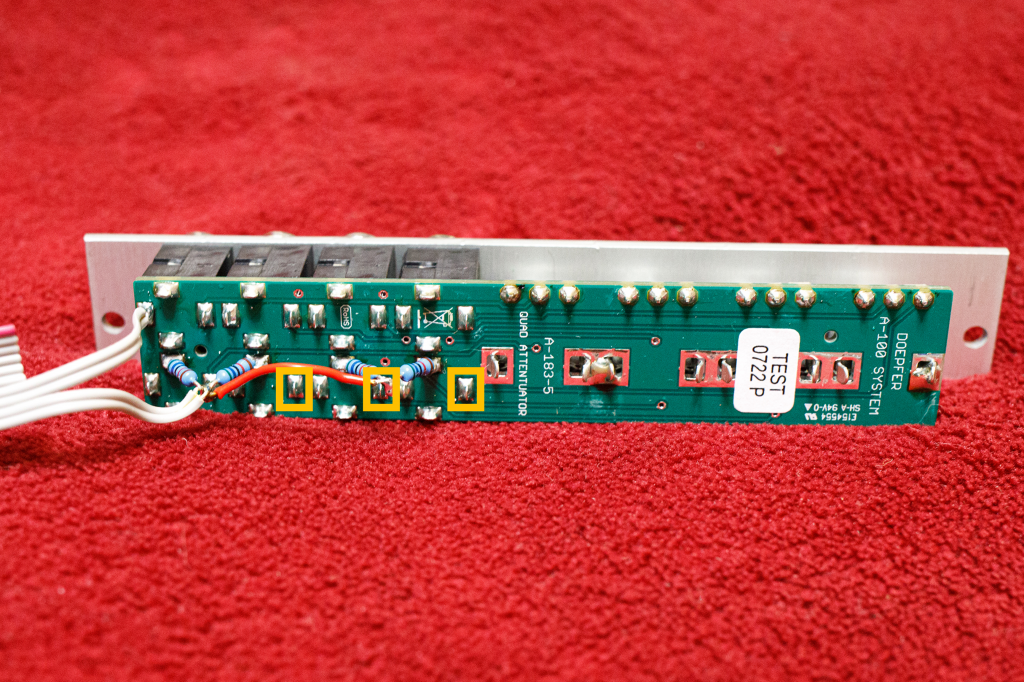Four manual attenuators in a slim 4TE module. Ok, this is definitely not an exciting module with lots of bling and two dozen hidden features. This is a tool. Simple, clear, and once you have it – indispensable.
For example, I have two A-183-1 Dual Attenuator Modules (now running out of stock modules) in my rack for many years and use at least one of them in every second patch: Some modules have modulation or audio inputs without their own attenuator (such as the A-132-1 or A-132-4 VCA). For some, attenuators for individual outputs would be practical (e.g. the A-152 T&H / Switch or the A-150-8 Switch). Most filters have control voltage inputs with attenuators, but also one without attenuators (and yes, sometimes you have actually already “used up” all the adjustable inputs, but would like to have another one…) Some of the new envelope generators output a full 10V, which one or the other amplifier module acknowledges with slight distortion, and an attenuator in between helps.
Additionally, the module can be modified so that it works as an adjustable quadruple voltage source. Something like this is quite practical, especially in polyphonic setups. Together with one or more A-130-8 Octal Linear VCAs, you can control the intensity of several modulation or audio signals at the same time. Here too, the A-176 CV Source is a module that is no longer produced and can be replaced by the Quad Attenuator.
User interface
Inputs:

- In 1-4: Four identically designed input sockets for audio signals or control voltages that are to be attenuated manually. There is a “Lev.” controller for each input in the upper area of the module. The input sockets are completely independent of each other, but the module can be modified to pre-assign the inputs “In 2” to “In 4”.
Outputs:

- Out 1-4: Four identically designed output sockets for the attenuated audio signals or control voltages from the inputs “In 1” to “In 4”.
Controls:

- Lev. 1-4: One attenuator each for the four inputs and outputs “In 1-4” and “Out 1-4” below.
Possible uses
Modules without their own attenuator
This is probably the most common use of an attenuator: A module does not have its own attenuator for an input or output, but you want to reduce the audio or control voltage signal slightly. This means that modulations are more subtle or audio signals are only passed on to a small extent to the other module. Most Doepfer filters have at least one attenuable control voltage input and all have attenuable audio inputs, but the Doepfer VCOs, for example, have some without attenuators for audio and/or control voltages: A-130-8, A-132-1, A-132-4, A-132-8 (attenuator for control voltages only, not for audio), A-134-2, A-138f, A-138u.
Some older modules may also not be operated as “hot” with control voltages as, for example, the new A-141-4 or A-140-2 ADSRs provide with their 10V output levels and then acknowledges this with slight distortion of the audio signal or a “compression” when the maximum control voltage is exceeded. An attenuator connected in between then ensures “normal” behavior again.
“Preset” control voltage
An additional attenuator can also be useful for modules with existing attenuators at the inputs: Let’s imagine that we want to use linear frequency modulation at a specific, musically meaningful point. Linear FM with analog VCOs is always a bit tricky; useful effects often require a precisely adjusted level of modulation. We set this level in advance on the modulated VCO and have connected an A-183-5 attenuator between this and the modulator VCO (which is of course completely open at level 10 when setting). As long as we don’t need the linear FM, our attenuator remains regulated to 0 and only at the right moment do we turn up the control of our A-183-5 slightly as needed or to the full extent, without having to pay attention to nuances in the hectic pace of performance.
Similar example: Transposing a VCO up a fifth, for example. We have modified the A-183-5 as a voltage source or use a constant voltage as an input signal. We previously set the modulation input of the VCO to the desired fifth with the A-183-5 fully open. Of course, if we set the A-183-5 to 0, nothing happens. When the attenuator is fully open, we get the previously set fifths. (If you want to switch between several different intervals at the push of a button, you will of course at some point use the A-173-1/2 Micro Keyboard.)
The attenuator always offers advantages when there are interesting intermediate positions and / or the process of opening the modulation path is interesting in terms of sound. Switches such as the A-182-2 Quad Switch and the A-184-4 Dual Rotary Switch or voltage controlled switches like the A-150-1 Dual VC Switch or the A-150-8 Octal VC Switch can of course also be used to simply switch a modulation source on and off.
Polyphonic mixer
Yes, the A-135-5 poly mixer is now finally available, with three inputs for each of the four voices. This is actually a long-awaited and very practical module for polyphony fans like me.
However, if you want to mix four audio or CV sources, you can use two A-130-8s and use the sum outputs “Sum Out 1-4” and “Sum Out 5-8” as mixes of four input signals each. Our A-183-5 (modified as a voltage source) then takes over the control of the two eight-fold VCOs. Further details can be found in the article on the A-130-8. Alternatively, two A-135-5s can be stacked and then offer 6 mixable channels… also a good solution.
Modifications
I usually hold back when it comes to “soldering” modules. Anyone who can do something like that can find their way around on their own and without my layman’s explanations, and anyone who can’t should of course stay away from it. I myself pretty much belong to the second group, although I have already held a soldering iron on the right side…
Quadruple control voltage source
This is what I had been hoping for for a long time, since the A-176 Manual CV Source is unfortunately no longer manufactured: four constant and manually adjustable control voltages in one narrow module! I actually need something like this quite often. Why there is hardly any demand for something like this on the Eurorack module market is a bit of a mystery to me…
Doepfer kindly built the modification for me. A bus connection cable is split and the ground line (GND) is connected to the ground connection of the module, and the 12V line is connected to the corresponding connection points of the module via four resistors. The four resistors for me each have 56kΩ, which results in a voltage range of around 0 to +5V for each of the four outputs of the module that can be adjusted using a potentiometer.

Without this modification, the quadruple attenuator is one of the powerless modules and could, if necessary, be installed in a simple wooden box without a transformer and mains connection.
Normalization of inputs
This modification is an alternative to converting the module into a quadruple voltage source – using the bus voltage and the voltage of the input above it at the same time would of course lead to a short circuit between these two voltage sources.

In principle, you connect the three live pins of the input sockets “In 1” to “In 3” with the pins for the inputs of the attenuators 2 to 4 – already used here for the other modification. These are the pins to which the three left resistors are connected.
Please do not carry out both modifications at the same time, as this would short-circuit the bus voltage with the voltages from the first three input sockets.
Alternatives
Quadruple attenuator
The previous “standard” for attenuators was the A-183-1 Dual Attenuator module, which will no longer be produced in the future. It offers two attenuators, which are designed completely analogously to the A-183-5: input socket – control for attenuating the signal – output socket. The whole thing is also on 4TE, so you need twice the space for our four attenuators.
The A-183-2 Offset Generator/Attenuator/Polarizer is much more convenient because it is equipped with an additional adjustable voltage source and a polarizer for the input signal. The only disadvantage: It only has one such unit (albeit much more comfortable) to offer on its 4TE. If you need several attenuators, you also need significantly more space.
There are two simple mixers to mention: The A-138i Interrupting Mixer and the A-138j Janus Mixer: In addition to their mixing function, the two 6TE modules also have individual outputs for the four inputs, so they can also be used as a quadruple attenuator. The A-138j also offers a switchable inverter for each input.
The A-138m matrix mixer, which can distribute four inputs arbitrarily to four outputs, is significantly more complex to operate in comparison. Of course you can also use it (in extreme emergency!) as a quadruple attenuator. But that would almost be a waste of the complex possibilities of the matrix mixer (which also brings a whopping 20 HP to the “rack space scale”).
If you work with polyphonic signals (regardless of whether CV or audio) and also need four-fold attenuation for all four “channels” in the same way and also voltage-controlled, then it’s worth taking a look at the recently announced A-130-4. It offers a common manual attenuation for its four inputs and outputs, but also a common voltage-controlled level control (VCA) – and that too in just 4 HP. Its predecessor was the (no longer manufactured and twice as wide) A-132-2 Quad VCA.
Quadruple voltage source
Using the modification described by Doepfer, the module can also be used as a quadruple source of manually adjustable control voltages. This is a highly recommended modification, as the only “real” alternative, the A-176 CV Source (with three adjustable voltage sources), is unfortunately no longer produced.
The A-174-2 Wheels module is an obvious – but with 14 HP (and extra space required to the left of the front panel) not nearly as space-saving – alternative: Here a voltage source is bipolar, but with a return spring in the modulation wheel. The second source is unipolar, comparable to the A-183-5, and remains at the last set control value, thanks to the right modulation wheel without a return spring.
The situation is similar with the joysticks A-174-1 and A-174-4: In principle we have two voltage sources, on the A-174-4 there is also a rotation axis on the joystick for a third voltage source, as well as a button for gate signals. But everything has return springs, so you can’t set a permanent constant value (unless you hold the stick in position manually…).
Finally, we have some mixers that output a constant and adjustable control voltage without an occupied input socket, such as the A-138a Linear Mixer, the A-138b Exponential Mixer or the A-138m Matrix Mixer. With the A-138 mixers, the control voltage is limited to the first channel of the mixer; we only get four independent control voltages with the fairly large A-138m or the modified A-183-5.
Technical specifications
| Width | 4 HP |
| Depth | 20 mm |
| Power requirements | Without modification (factory setting): 0 mA (+12V) / -0 mA (-12V) |
